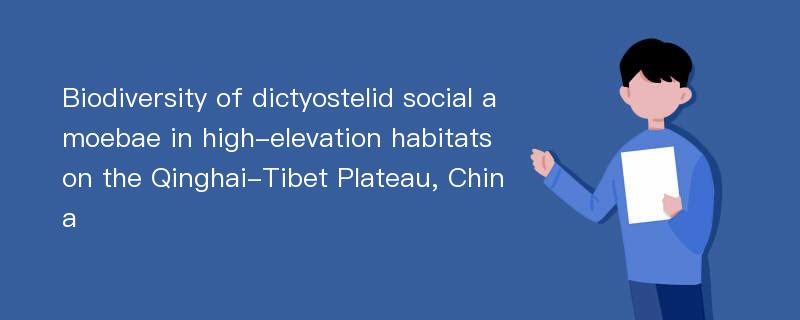
论文摘要
Dictyostelid social amoebae(dictyostelids) are the second largest group of slime molds. Members of the group live in the soil and feed upon bacteria and other microbes. The Qinghai-Tibet Plateau, which is the highest plateau in the world, is characterized by unique and important forest types because of the considerable range in elevation which exists. Studies of dictyostelids in this region are exceedingly limited and consist of a single previous report of a species new to science. During the period of 2012, 2013 and 2016, samples of soil and animal dung for the isolation of dictyostelids were collected on the Qinghai-Tibet Plateau. These samples yielded12 species of dictyostelids, including two new species(Dictyostelium minimum Li Y., P. Liu et Y. Zou, and D.multiforme Li Y., P. Liu et Y. Zou). Three species(D. brevicaule var. brevicaule, D. vermiformum, and Hagiwaraea fasciculata) were new records for China. Six other species(D. brefeldianum, D. crassicaule, H.antarctica, H. aureostipes, H. exigua, and Heterostelium tikalense) were new records for the Qinghai-Tibet Plateau. Within China, H. exigua had been reported previously only from Taiwan, H. antarctica from Hubei Province, H. aureostipes from Liaoning Province, D. crassicaule from Guizhou Province, and H. tikalense from Jilin Province. Dictyosteliun brefeldianum had been reported from the Jilin, Fujian, and Taiwan provinces prior to the present study, and D. sphaerocephalum had been reported previously from the Heilongjiang, Tibet, Henan and Hainan provinces. Observations of the life cycle and ultrastructure of the new species D. minimum and D.multiforme confirm that they are new species and the surface of their spores has a distinctive ornamentation. The completion of the entire life cycle of D. minimum and D. multiforme requires 56 h and 41 h, respectively.Phylogenetic studies of both new species, based on ITS and SSU, indicate that D. minimum and D. multiforme are members of Group 4 B-D. In the SSU phylogenetic tree generated in the present study, Synstelium was assigned to the clade Acytosteliaceae in the Acytosteliales. To our knowledge, the study reported herein is the first investigation of dictyostelid biodiversity carried out at elevations between 2000 m to 5000 m. Sorocarp size, sorus size, spore length, ratio of sorus and sorophore, and ratio of sorus and spore size were positively correlated with increasing elevation, according to the results of linear regression analysis.
论文目录
文章来源
类型: 国内会议
作者: Pu Liu,Yue Zou,Qi Wang,Yu Li
来源: 多彩菌物 美丽中国——中国菌物学会2019年学术年会 2019-08-03
年度: 2019
分类: 基础科学
专业: 生物学,生物学
单位: Engineering Research Center of Chinese Ministry of Education for Edible and Medicinal Fungi,Jilin Agricultural University
分类号: Q949.32
DOI: 10.26914/c.cnkihy.2019.001953
页码: 33
总页数: 1
文件大小: 822k
下载量: 2
